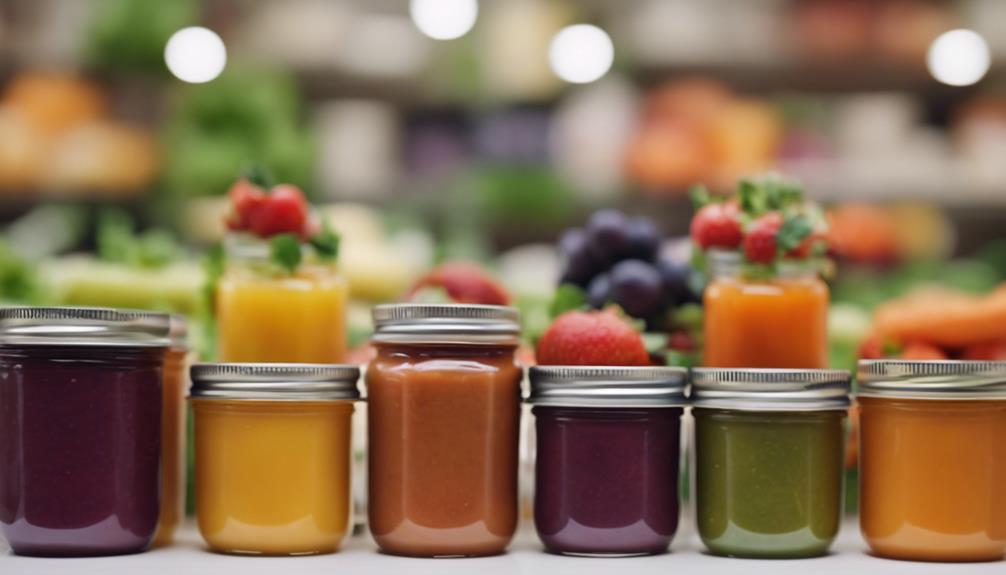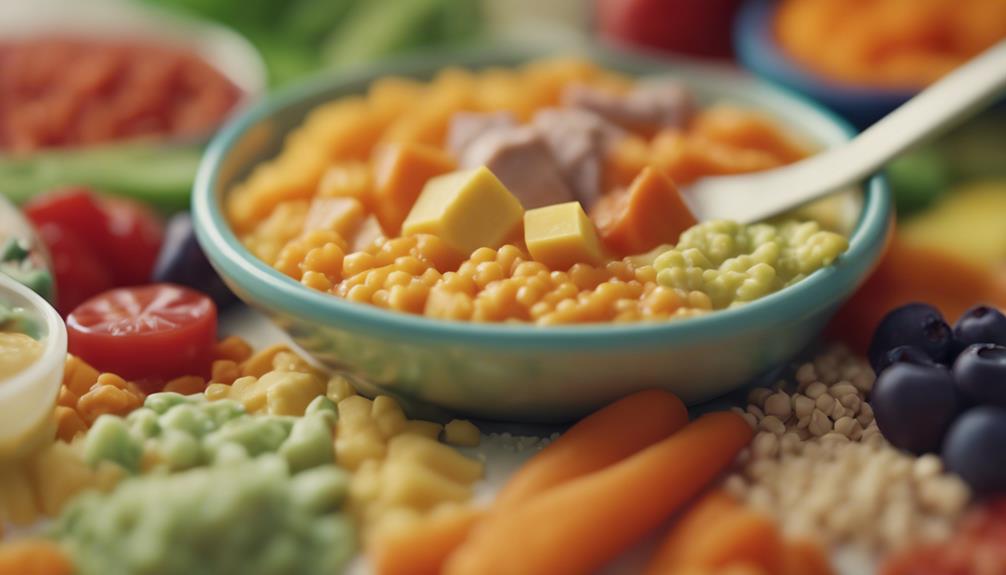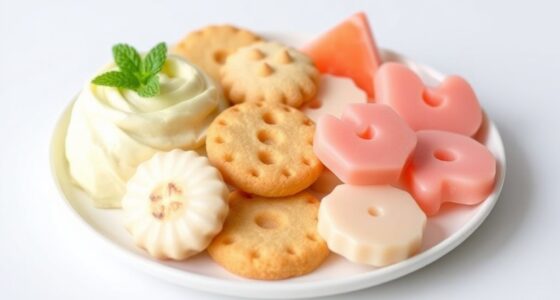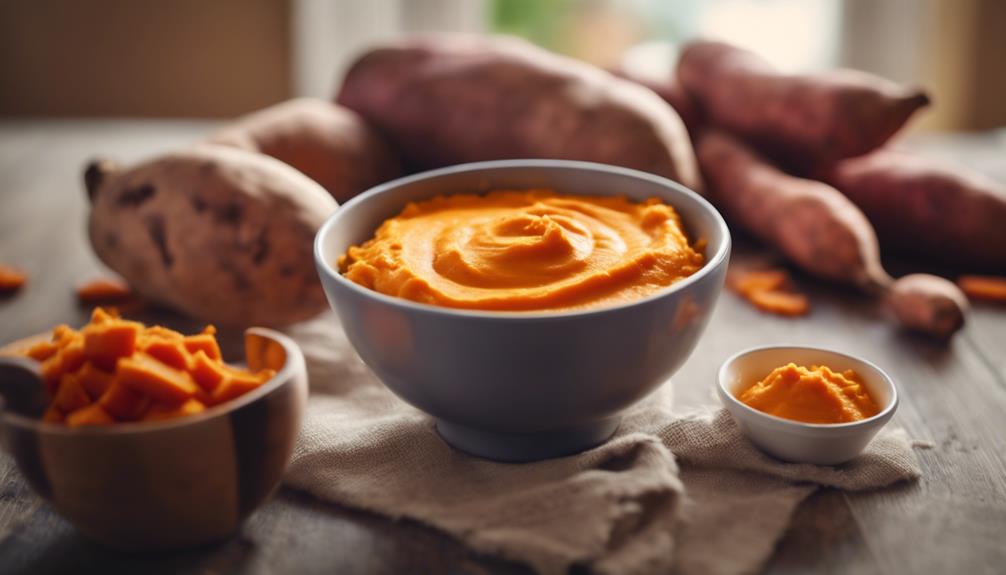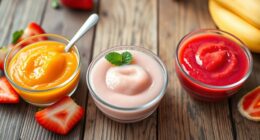When nourishing your infant with simple and nutritious meals, homemade baby food recipes are crucial. They provide a cost-effective way to tailor essential nutrients and flavors to your baby’s preferences. Beginning with nutrient-dense options like egg yolk or liver ensures proper iron intake. Start with soft or pureed foods initially, gradually transitioning to more textures. Introducing solid foods between 4-6 months can reduce the risk of anemia, so keep an eye out for signs of readiness. Remember, breast milk remains important even after solids are introduced. Stay curious and try out different flavors to broaden your baby’s palate and support their healthy growth and development.
Key Takeaways
- Prioritize nutrient-dense foods like sweet potatoes and avocados.
- Experiment with flavor combinations for a varied palate.
- Keep recipes simple for nutritional value and enjoyment.
- Choose wholesome ingredients such as fruits, vegetables, and lean proteins.
- Focus on essential vitamins and minerals crucial for growth.
Baby Food Readiness
To determine if your baby is ready for solid foods, look for signs such as good head control, ability to sit up, and interest in food. When your baby starts showing curiosity about what you're eating, opens their mouth when food is offered, or reaches out for your meal, these are indications that they may be ready for solid foods. Pediatricians recommend introducing solid foods between 4-6 months when babies exhibit these signs to reduce the risk of anemia and guarantee proper nutrition.
Making sure that your baby can sit upright and hold their head steady are critical factors in determining their readiness for solid foods. Introducing solid foods when your baby is developmentally prepared can make the transition to more complex textures easier, potentially preventing feeding difficulties and fostering healthy eating habits for the future.
Essential Solid Foods

When introducing solid foods to your baby, prioritize nutrient-rich options like egg yolk or liver for essential iron intake.
Begin with soft or pureed foods before moving to textures to promote healthy eating habits.
Encourage independent eating skills by offering appropriate finger foods that are easy for your baby to pick up and feed themselves.
Nutrient-Rich First Foods
Introduce nutrient-rich first foods like iron-rich egg yolk or liver from your plate to help prevent anemia in your 6-month-old baby. These iron-rich foods are essential in providing the necessary nutrients for your baby's growth and development.
When starting solid foods, opt for soft or pureed options as initial choices to make it easier for your baby to consume. Homemade baby food is a great way to make sure that your little one gets all the essential nutrients without any additives or preservatives.
As your baby grows, around one year old, you can introduce finger foods. These foods not only promote self-feeding but also offer a variety of textures and flavors.
Transitioning to Textures
Gradually incorporating thicker purees and mashed foods into your baby's diet helps them adapt to solid foods and develop important oral motor skills.
As your baby grows, introducing a variety of textures like soft chunks or small pieces of fruits and vegetables can encourage self-feeding and independence.
These textured foods not only provide sensory experiences but also help your little one explore different tastes and flavors, contributing to their overall development.
Introduction to Baby Foods

You're now entering the exciting phase of introducing your baby to the world of solid foods. This journey into the domain of baby food is an important step in your infant's nutrition and development.
Here are some essential points to keep in mind:
- Timing is Key: Introducing solid foods around 6 months of age can help prevent anemia and support your baby's growth and development.
- Signs of Readiness: Look for signs like good head control and the ability to sit up independently, indicating your baby is ready for their first foods adventure.
- Nutrient-Rich Choices: Starting with iron-rich foods such as egg yolk can provide essential nutrients for your little one's development.
- Continuing Breast Milk: Remember, breast milk remains a crucial source of nutrition even after introducing solid foods. It's a perfect complement to the exciting new flavors and textures your baby will explore.
As you start on this journey of introducing your baby to solid foods, remember to enjoy the process and savor these precious moments of discovery with your little one.
Homemade Baby Food Tips

Consider making your own baby food at home to guarantee quality and cater to your baby's preferences. Homemade baby food allows you to control the ingredients, avoiding additives often found in store-bought options. You can easily customize flavors and textures to suit your little one's tastes, ensuring a variety of nutritious options. Making baby food at home isn't only beneficial for your baby but also cost-effective compared to purchasing pre-made varieties. All you need are basic cooking supplies like a blender or food processor to prepare delicious meals for your little eater.
When making homemade baby food, remember that you can store it in the refrigerator for a few days or freeze it for later use. This way, you can conveniently have nutritious meals ready whenever your baby needs them.
Nutritious Baby Food Recipes
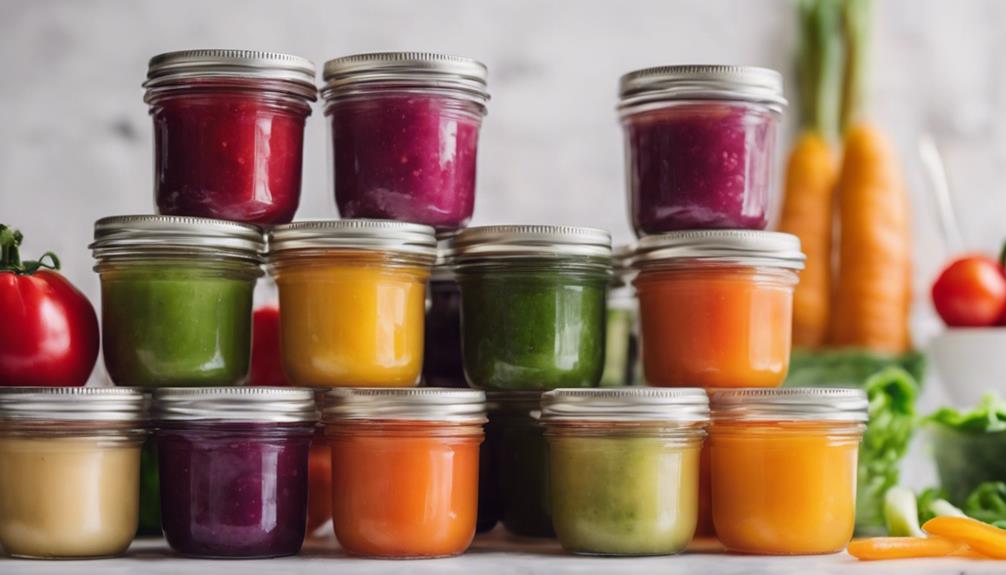
For creating nutritious baby food recipes, focus on incorporating essential vitamins and minerals to support your infant's growth and development.
When preparing homemade baby food, consider these tips to guarantee your little one receives the best nutrition possible:
- Choose Wholesome Ingredients: Opt for fresh fruits, vegetables, lean proteins, and whole grains to provide a wide range of nutrients essential for your baby's development.
- Experiment with Flavor Combinations: Introduce various flavors and textures to help expand your infant's palate and encourage healthy eating habits from an early age.
- Prioritize Nutrient-Dense Foods: Focus on nutrient-dense ingredients like sweet potatoes, avocados, and lentils to make sure your baby gets the most out of each bite.
- Keep It Simple: While exploring different recipes, remember to keep the ingredients and preparation methods simple to maintain the nutritional value and make mealtimes enjoyable for your little one.
Storage and Preparation Tips
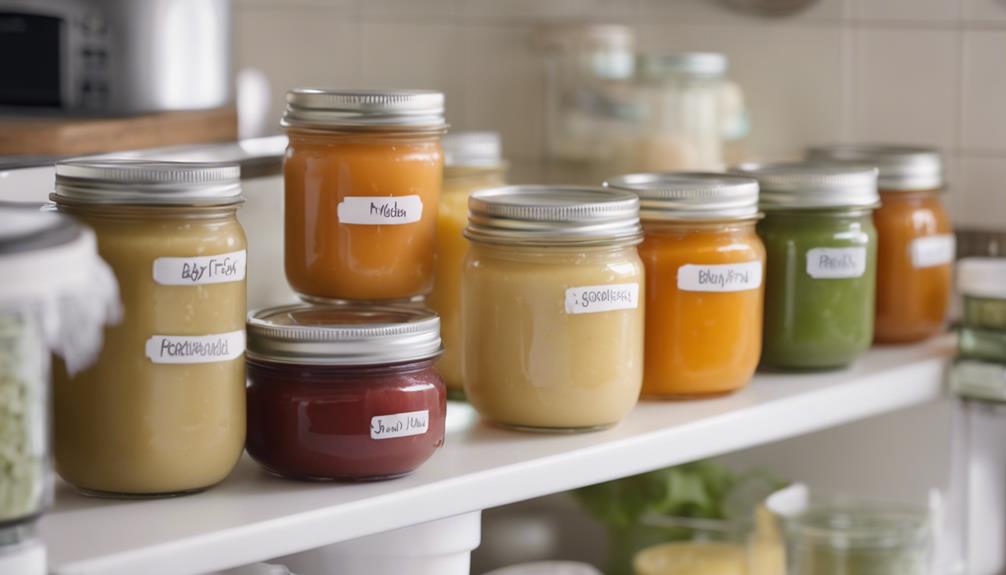
To guarantee the freshness and quality of your homemade baby food, store it in a sealed container in the refrigerator for up to 3 days.
For longer storage and easy portioning, freeze baby food in ice cube trays or a freeze dryer for up to 3 months.
Utilize a suitable base, like breast milk or formula, when blending homemade baby food to achieve the desired consistency for your little one.
Storage Tips for Freshness
Proper storage of homemade baby food is essential for maintaining its freshness and quality. To guarantee your little one gets the best nutrition from their meals, follow these storage tips:
- Refrigeration: Store homemade baby food in sealed containers in the refrigerator for up to 3 days to keep it fresh and safe.
- Freezing Methods: Utilize ice cube trays or a freeze dryer to freeze baby food for longer storage while preserving essential nutrients.
- Flavor and Texture Preservation: By correctly storing homemade baby food, you can retain flavors and textures, ensuring peak taste for your baby.
- Defrosting: Remember to defrost frozen baby food cubes in the refrigerator overnight before serving. This helps maintain the quality of the food while ensuring it's safe for consumption.
Quick Preparation Methods
Guarantee your homemade baby food stays fresh and convenient with these quick preparation methods for storage and preparation. When making baby food at home, it is crucial to make sure that you store it properly to maintain its nutritional value and freshness. Here are some quick and easy tips to help you with storage and preparation:
| Quick Preparation Methods | Description |
|---|---|
| Refrigeration | Store homemade baby food in sealed containers in the refrigerator for up to 3 days to keep it fresh and ready to serve. |
| Freezing | Freeze baby food in ice cube trays or a freeze dryer for longer storage, up to 3 months, providing convenient portions ready to use when needed. |
| Thinning | Use a sufficient base for blending homemade baby food and thinning it with liquids like breast milk or formula for the right consistency. |
Meal Planning Strategies
Make sure your meal planning for homemade baby food incorporates efficient storage and preparation strategies to maintain freshness and convenience.
Here are some tips to help you organize and prepare your baby's meals effectively:
- Storage: Store homemade baby food in sealed containers in the refrigerator for up to 3 days to guarantee freshness. For longer storage, freeze the food in ice cube trays or a freeze dryer for up to 3 months, allowing you to have convenient portions ready at all times.
- Base for Blending: Use a suitable base like breast milk or formula when blending homemade baby food to achieve the desired consistency. This will help in providing the necessary nutrients and maintaining a smooth texture for your baby.
- Adjusting Texture: Thin homemade baby food with liquids such as water, breast milk, or broth to adjust the texture according to your baby's preference. This allows for a customized feeding experience that suits your baby's needs.
- Defrosting: When serving frozen baby food cubes, defrost them in the refrigerator overnight to ensure safe consumption and maintain the food's quality.
Frequently Asked Questions
What Is the Healthiest Way to Make Baby Food?
The healthiest way to make baby food is by using fresh, organic ingredients. Avoid salt, sugar, or artificial additives. Steam or bake fruits and vegetables to retain nutrients. Customize flavors and textures with a blender for smooth purees.
What Are Easy Foods for Babies to Eat?
You should offer soft and pureed foods like apple, avocado, and banana puree for easy eating. Try finger foods such as broccoli and butternut squash puree. Introduce simple and nutritious options like cantaloupe, mango, and green bean puree.
What Can Be Mixed With Baby's Regular Meals to Make Them More Nutritious?
To make your baby's meals more nutritious, try adding pureed veggies like carrots and sweet potatoes, fruits such as apples and bananas for sweetness, protein sources like chicken or tofu, and healthy fats like avocado or olive oil.
What 3 Meals Should a Baby Eat?
You should aim for three meals a day for your baby by 9-12 months. Guarantee variety with protein, carbs, healthy fats, vitamins, and minerals in each meal. Different textures and flavors help develop their palate.
Conclusion
To sum up, making your own baby food can be a rewarding and nutritious choice for your little one. Did you know that babies typically triple their birth weight by their first birthday?
By preparing homemade meals packed with essential nutrients, you can guarantee your baby is getting the best start possible.
So, don't be afraid to try out these simple recipes and give your baby the healthiest start to their journey of solid foods.

